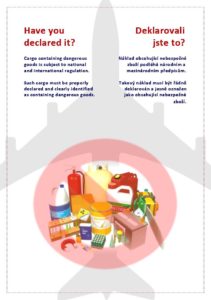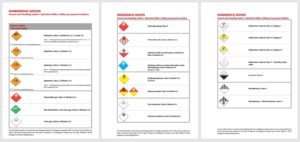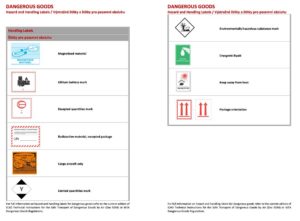There are several groups of dangerous goods
- dangerous goods than cannot be carried by air freight under any circumstances
- dangerous goods forbidden under normal circumstances but which may be carried with specific approvals from the States concerned
- dangerous goods restricted to be carried only on all-cargo aircraft (CAO)
- dangerous goods which can be carried on both passenger and all-cargo aircraft, subject to meeting the required conditions stated in ICAO Technical Instructions for the Safe Transport of Dangerous Goods by Air (ICAO Doc 9284)
What are dangerous goods?
Dangerous goods are articles or substances which are capable of posing a risk to health, safety, property or the environment and which are shown in the list of dangerous goods in ICAO Technical Instructions for the Safe Transport of Dangerous Goods by Air (ICAO Doc 9284), or which are classified according to these Instructions.
Cargo containing dangerous goods is subject to national and international regulation. Such cargo has to be properly declared and clearly identified as containing dangerous goods. Cargo declared under a general description may contain hazardous items that are not apparent.
These can be common items as:
- automobile parts may contain engines which contain and have contained fuel, wet or lithium batteries, compressed gas, fire extinguishers, air bag inflators, flammable adhesives, paints etc.
- battery-powered devices/equipment may contain wet or lithium batteries
- chemicals may contain items meeting any of the criteria for dangerous goods, particularly flammable liquids, flammable solids, oxidizers, organic peroxides, toxic substances, corrosive substances
- COMAT (company materials) such as aircraft parts, may contain dangerous goods as integral part, e.g. chemical oxygen generators in a passenger service unit (PSU), various compressed gases such as oxygen, carbon dioxide, nitrogen, gas lighters, aerosols, batteries, flammable liquids as fuels, other items such as flares, life-saving appliances, magnetized material etc.
- drilling and mining equipment may contain explosives and other dangerous goods
- electrical/electronic equipment may contain magnetized materials or mercury in switch gear, wet batteries, lithium batteries, fuel cells or fuel cartridges that contain or have contained fuel
- frozen embryos may contain refrigerated liquefied gas or Carbon dioxide, solid (dry ice)
- frozen fruit, vegetables may be packed in Carbon dioxide, solid (dry ice)
- machinery parts may contain adhesives, paints, solvents, wet and lithium batteries, mercury, cylinders of compressed or liquefied gas etc.
- pharmaceuticals may contain items meeting any of the criteria for dangerous goods, particularly radioactive material, flammable liquids, flammable solids, oxidizers, organic peroxides, toxic substances, corrosive substances
- racing car or motorcycle team equipment may contain engines, carburettors, fuel tanks which contain fuel or residual fuel, flammable aerosols, cylinders of compressed gases, wet batteries, lithium batteries etc.
- show, motion picture, stage and special effects equipment may contain flammable substances, explosives and other dangerous goods

Classes of dangerous goods
Dangerous goods are divided into nine classes according to the hazard they present, some classes have as well divisions. A detailed list of dangerous goods is shown in ICAO Technical Instructions for the Safe Transport of Dangerous Goods by Air (ICAO Doc 9284) and it indicates the class or division into which each article falls, its acceptability for air transport and under what conditions.
In order to ensure that packages containing dangerous goods can be recognised and warning given of the potential hazard(s) without relying on information in accompanying documentation, packages of dangerous goods are marked with essential information, including proper shipping name and UN number and hazard labels showing all the potential hazard(s) of the contents.


How else can I find if the goods are dangerous?
- Look for a diamond-shaped hazard label on the packaging.
- If you cannot see a label then look for a UN number. This will be the letter “UN” followed by four numeral digits – such as UN 2844 or UN 1748.
- Look for if a hazard class is written on the packaging – it will be something like “Class 8” or “Corrosive”.
- If you think the article might be dangerous but you cannot find any of described indicators, look for a material safety data sheet (MSDS) on the internet.
- It is also possible to search online by typing in the manufacturer of your product, then the letters “MSDS”, and then the product name.
- If you have the MSDS, look for the entries “UNxxxx”, hazard class and transport information.
- You can also contact the manufacturer or distributor using the customer information phone number which can be found on most household products.
- Your airline or freight forwarder can also answer your dangerous goods queries.